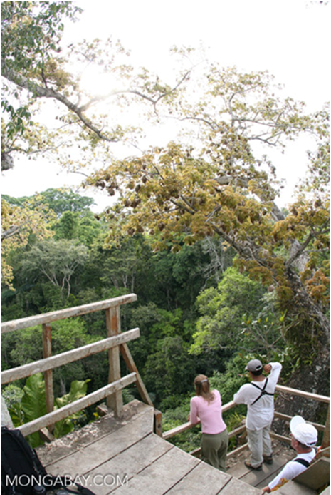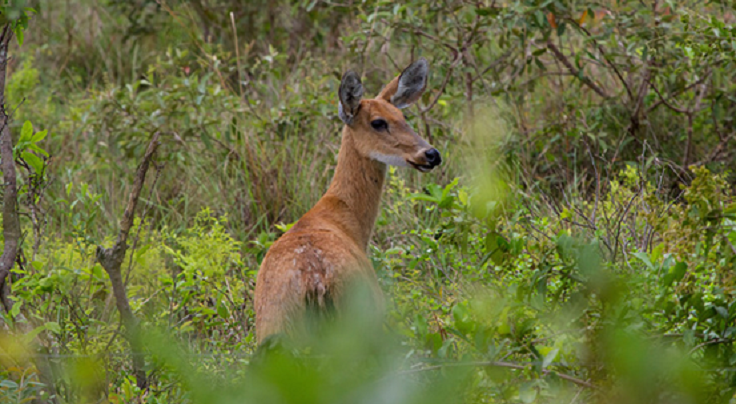- In a meta study of 274 papers, researchers found that 59% of the time impacts on wildlife were negative.
- Reptiles, amphibians and invertebrates appear especially vulnerable to tourist impacts.
- More research is needed, especially in the developing world.
In a video posted on YouTube on February 6, 2017, a woman fishes a juvenile shark out of the waters of the Fernando de Noronha, an archipelago-cum-national park off Brazil’s northeastern coast, wrestling with it as it thrashes furiously. As the clip plays, we realize the shark has clamped down on her right hand. A camera-bearing man moves into the frame and grabs the shark’s tail, trying forcefully to pry it off as a crowd gathers. After an agonizing twenty seconds, the man detaches the shark’s grip from the woman’s hand, and she throws the shark back into the ocean.

It later transpired that the shark was an endangered lemon shark, and that there were signs around the park telling visitors not to kill, catch, disturb or feed animals in the park. The woman was fined around $6,420.
To most people, having an area declared protected seems like a cause for celebration. Animals flourish, while humans get to enjoy nature – what’s not to like? But if this is true, why do stories like these keep showing up in the news and what impact do tourists have on the ostensibly protected species?
Enter a team of scientists who decided to try and dig deeper. Their study, recently published in PLOS ONE, surveys 274 papers to better understand the impact human recreation has on wildlife in protected areas.
“It’s common to assume that we can set aside land as protected, and it will do the job of conserving wildlife even if there are high levels of human activity in those areas,” said Courtney Larson, a Ph.D. student at Colorado State University, and team lead for the study. “We were interested in synthesizing the research that is out there on this topic and seeing if we could identify some patterns.”
The team also aimed to discover gaps in the existing literature.
First, the researchers decided that a bad impact on wildlife would mean signs like lower species richness, less survival and reproduction, or decreased weight. A good impact would mean just the opposite. Everything else would be categorized as “unclear.”
They found that 93% of the papers had at least one impact on wildlife from recreation. And 59% of the time, it was bad.
All uphill
The research came with many challenges. To identify gaps, the scientists needed as broad a scope as possible, including all types of wildlife and recreation activities in protected areas all over the world. This means they had to grapple with the myriad ways recreation affects wildlife.
For example, the researchers noticed that recreation’s negative effects appeared to occur most often to reptiles, amphibians and invertebrates. One paper documented how the Iberian frog (Rana iberica) stopped using stream banks with higher levels of human use. Another tracked the flat-tailed horned lizard (Phrynosoma mcallii) in the Colorado desert and found that lizards in areas with more off-highway vehicle activity had lower densities and mean body masses.

But the two hundred-plus papers focused on such vastly different topics that it made it difficult for them to say why these animals were more vulnerable – or if this was simply a case of skewed sampling.
Surprisingly, they found that negative impacts were more often reported in relation to non-motorized activities, like hiking and boating, than motorized activities like viewing wildlife from off-highway vehicles. But the reason for this was also unclear.
“This is absolutely a topic where more research would increase our understanding,” Larson said. “It’s important to keep in mind that there were very few studies that directly compared the effects of non-motorized and motorized activities. Additionally, we were not able to account for the fact that motorized activities usually cover larger areas than non-motorized activities, and can cause soil erosion and vegetation disturbance.”
We’re working on it
The team also discovered some creative ideas people have carried out to try and minimize their negative impact on wildlife. For instance, some taught divers how to avoid damaging coral reefs, while others used official-looking volunteers to deter people from disturbing fur seals. Two papers examined whether fencing off protected areas helped keep people away.
“[W]e don’t know enough about how effective these mitigation strategies are, so it’s difficult to say whether they are adequate,” said Larson, adding, “It’s also important to keep in mind all the benefits outdoor recreation provides for people – mental and physical health, connecting with nature, and a source of revenue for local communities. Rather than talking about curbing demand I think we need to explore more ways to balance these uses.”
Gaps to fill
More than anything, Larson and her team identified various topics where research is scant.
For one, they found that winter recreation seemed to have a greater impact on animals than summer activities. But because there were so few articles comparing winter and summer recreation, they could not be sure why this was so. Although it is likely that animals require more energy to escape from humans in snow, and that moving away from humans is harder given that food sources are scarcer in the winter, the team emphasized that more research has to be done.
There was also a dearth of papers on recreation impacts in Africa, Latin America and Asia, since the research was conducted mostly in North America (37.7% of the papers), Europe (26.6%), and Oceania (13.1%). South America (9.1%), Asia (5.5%), Africa (5.1%), and Antarctica (2.9%) were largely ignored in the literature. Significantly, such percentages are disproportional both to the land area and to human population density of the continents.
Finally, effects on individual animals need to be examined on a larger scale to understand how recreation might impact wildlife populations or communities.

“What can be measured almost always takes precedence over what cannot,” wrote essayist, environmentalist and historian Rebecca Solnit in her essay “Woolf’s Darkness: Embracing the Inexplicable.” With this piece of research, Larson and her team have pointed us somewhere new – towards a place where our relationship with animals is tangible and quantifiable; one capable of being measurably improved.
And so, far from being shortcomings, these unanswered questions could be the legwork that helps us to begin to decipher the – as Solnit puts it – “mysteries and meanings” of our relationship with the 8.7 million or so other species that share our planet.
Citations:
Larson, C. L., Reed, S. E., Merenlender, A. M., & Crooks, K. R. (2016). Effects of Recreation on Animals Revealed as Widespread through a Global Systematic Review. Plos One, 11(12). doi:10.1371/journal.pone.016725
(2017, February 9.) Tourist in trouble after grabbing shark for a video. news.com.au. Retrieved from http://www.news.com.au/travel/travel-updates/incidents/tourist-in-trouble-after-grabbing-shark-for-a-video/news-story/8763b0311b5441174e1a8025ac69292a
Rodriguezprieto, I., & Fernandezjuricic, E. (2005). Effects of direct human disturbance on the endemic Iberian frog at individual and population levels. Biological Conservation, 123(1), 1-9. doi:10.1016/j.biocon.2004.10.003
McGrann, M., Wright, G., Dial, R., McGrann, A. (2006). Off-highway vehicle impact on the flat-tailed horned lizard, Phrynosoma mcallii, in the Colorado Desert of southern California. California Fish and Game 92:67-80.
Medio, D., Ormond, R., & Pearson, M. (1997). Effect of briefings on rates of damage to corals by scuba divers. Biological Conservation, 79(1), 91-95. doi:10.1016/s0006-3207(96)00074-2
Acevedo-Gutiérrez, A., Acevedo, L., & Boren, L. (2010). Effects of the Presence of Official-Looking Volunteers on Harassment of New Zealand Fur Seals. Conservation Biology, 25(3), 623-627. doi:10.1111/j.1523-1739.2010.01611.x
Cassini, M., Szteren, D., & Fernandez-Juricic, E. (2004). Fence effects on the behavioural responses of South American fur seals to tourist approaches. Journal of Ethology, 22(2). doi:10.1007/s10164-003-0112-0
Ikuta, L. A., & Blumstein, D. T. (2003). Do fences protect birds from human disturbance? Biological Conservation, 112(3), 447-452. doi:10.1016/s0006-3207(02)00324-5
Solnit, R. (2014). Men Explain Things to Me: And Other Essays. London: Granta.
Watson, Traci. (2011, August 25.) 86 Percent of Earth’s Species Still Unknown? National Geographic News. Retrieved from http://news.nationalgeographic.com/news/2011/08/110824-earths-species-8-7-million-biology-planet-animals-science/
